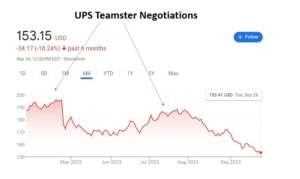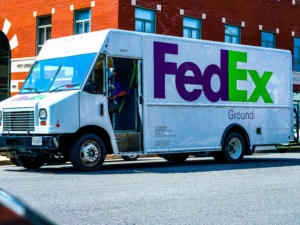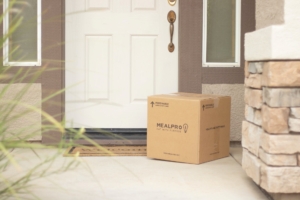UPS and DOWNS in the Parcel World
UPS and DOWNS in the Parcel World
The rise and fall of FedEx and UPS stock prices, and what it means for you
If you have been following UPS and FedEx Stock prices for the past 6 months, you have probably noticed some major differences in performance. During this period, UPS Stock has seen a decline of over 18%, while the FedEx stock price has increased by almost 20%. While you may think that these swings are only important for the stockholders of these respective companies, we feel that this is equally important for shippers.
To explain this, the first important question to ask is, what is driving these major changes? If you have been following the blogs that we have been putting out for the past few months, you probably have a good idea already.
We had been monitoring and reporting on the UPS/Teamster negotiations that started back in April. The negotiations were quite contentious, and ended with UPS providing an offer that the Teamsters touted as “Historic”, and that will cost UPS $30 Billion over the life of the new five-year agreement.
UPS leadership has publicly debated how much this new agreement will actually cost the company. However, regardless of how much, it is pretty obvious that it is going to increase their costs in a meaningful way.
The chart below illustrates the performance of UPS Stock price over the past 6 months. As you can see there was a big drop in value following the kick-off of negotiations, most likely driven by the negative sentiment and risks associated with a potential strike by the Teamsters.

The stock has continued to fall following the completion of negotiations, and has seen a steady decline since UPS reported Q2 earnings at the beginning of August. This UPS earnings report acknowledged the loss of volume due to customer concerns of the outcome of their negotiations with the Teamsters. UPS also lowered its revenue outlook for the year following the outcome of the new agreement.
For FedEx, there has been a steady uptick in their stock price. As you can see in the chart below, their stock has risen substantially during the same period.

FedEx earnings reports have suggested that they have been successful in reducing costs and have solid plans to continue doing so. However, they have also acknowledged the fact that UPS/Teamsters negotiations have helped them gain market share.
FedEx’s chief customer officer, Brie Carere, said “We onboarded new customers who valued our service, and were committed to a long-term partnership with FedEx,” she said on the company’s earnings call Wednesday. “As a result, we added approximately 400,000 in average daily volume by the end of the first quarter.” She then went on to say “My job is to make it very difficult for our primary competitor to win back that share.”
In case you didn’t catch it, the statement made by Ms. Carere should be the aha moment that explains why these fluctuations in stock prices are important to shippers! The bottom line is that both carriers have a need for volume right now. The economy is soft, which is having a negative impact on volume. UPS needs to recoup volumes lost due to Teamster contract negotiations, and FedEx has won volume from UPS that they don’t want to lose. Seems like the perfect storm for shippers. This suggests that carriers might be willing to get aggressive with pricing to protect and or grow their volumes.
So, now you are probably thinking that you need to call your respective UPS or FedEx rep to try to take advantage of this situation. Maybe you have been successful in the past with obtaining better rates and discounts directly from your carriers. Maybe you have built and used successful strategies in the past that resulted in cost reductions for your company. But before you pick up your phone to call your reps, there are some very important questions that you need to ask yourself.
- How well do you understand your own Parcel Data? Do you have the visibility that you need to understand your shipment characteristics and trends of your parcel spend? Are you relying on data/reporting that comes directly from the carrier to understand your volumes? (bad idea #1)
- How do you know that you will be able to obtain the best rates possible from your carriers? What do you have to compare this to? Are you going to bench mark new offers against your own existing rates and discounts? (bad idea #2)
- Do you have the ability to completely analyze and determine the true impact of offers that you receive? Will your analysis pick up on discount details that you feel will not be impactful, but actually are? Are you going to take your carrier rep’s word for it when they tell you that their new offer is going to save you money? (you guessed it- bad idea #3!)
Our long term experience tells us that instead of picking up the phone to call your carrier rep, you should first pick-up the phone to call us. Here’s why;
- The proprietary analytical program/process that we have built along with our associated Auditing & Reporting portal allows for unmatched visibility and reporting. THIS WILL TRULY ALLOW YOU TO UNDERSTAND YOUR PARCEL VOLUMES AND SHIPPING CHARACTERISTICS!
- Shippers have no way of knowing that they are receiving the best rates and discounts possible on their own. Do not take your carrier rep’s word for it. ICC Logistics utilizes a vast database of over $9B/yr. in carrier data that allows for highly accurate benchmarking of rates and discounts. WE KNOW WHAT THE BEST RATES AND DISCOUNTS LOOK LIKE!
- Our analysis will provide a true and accurate picture of the impact of all carrier offers. We have protected many customers from accepting offers that carriers claim would reduce costs, and that would actually have had little impact or even increase costs. DON’T BE FOOLED BY SMOKE AND MIRRORS!
So if you are looking to enter into negotiations with your carriers from a position of power, it is imperative to partner with a company that understands the process. Market conditions suggest that now is the time to dust off your parcel carrier contracts, and take advantage of potential cost reductions. The Parcel market is ever changing, and the pendulum can quickly swing back the other way as capacity tightens. We are certain that our approach to negotiations will help shorten the timeline and result in the highest level of savings possible. So, be sure to reach out to us today to get things moving right away!














